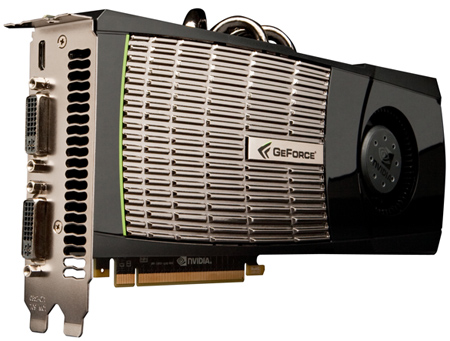NVIDIA GeForce GTX 480: GF100 Has Landed
Our Summary and Conclusion

Performance Summary: NVIDIA has created a powerful GPU in the GF100, as our performance data of the new GeForce GTX 480 has shown. Generally speaking, versus the single-GPU powered Radeon HD 5870, the GeForce GTX 480 is on average roughly 5% - 10% faster, give or take a few percentage points depending on the test, which technically makes it the fastest single-GPU on the market (almost). The GeForce GTX 480 held had the largest lead in the DX11-based Unigine Heaven benchmark and in Tom Clany's H.A.W.X. Unfortunately for NVIDIA, however, the Radeon HD 5870 is cheaper to produce, consumes less power, is quieter, and it costs about 25% less ($499 vs $399). And AMD also has the dual-GPU powered Radeon HD 5970 in its arsenal, which remains the fastest single-graphics card available for most current game titles.
The GeForce GTX 480's performance lead over the Radeon HD 5870 increase when paired up in a dual-GPU SLI configuration. With their current drivers, NVIDIA-power cards offered better performance scaling in multi-GPU configurations, which resulted in larger performance increases for the GeForce GTX 480. With that in mind however, a dual-card Radeon HD 5970 quad-CrossFireX configuration was still fastest overall.
![]()
Depending on your perspective, today will either be considered a great victory or perhaps a crushing defeat for NVIDIA. On one hand, the company has produced was is undoubtedly the most powerful and complex graphics processor in the world. The 3-Billion transistor GF100 is a very capable chip, both in terms of gaming and in terms of compute performance and NVIDIA owns the single-GPU performance crown again. The GeForce GTX 480 is faster than the Radeon HD 5870 overall and its forward thinking design lays the foundation for future generations of NVIDIA processors moving forward, as the G80 did for much of the previous generation. On the other hand, the GeForce GTX 480 is late to market, the GPU consumes a lot of power and hence generates a lot of heat, even with "only" 480 of its 512 shader cores exposed, and its performance lead doesn't exactly jibe with its projected 25% price premium.

The NVIDIA GeForce GTX 480 Reference Card
Although the company is announcing the cards tonight at the PAX event taking place in Boston, MA, widespread e-tail availability of both GeForce GTX 480 and GTX 470 cards, at prices of $499 and $349 respectively, won't happen until the week of April 12, 2010. Questions linger as to how many GF100-based graphics cards will ultimately hit store shelves, but NVIDIA tells us plenty are on the way. NVIDIA claims, "We are building 10s of thousands of units for initial availability, and this will ensure our partners have ample volume for what is the most anticipated GPU launch ever." If you're an NVIDIA fan and have been waiting for their next-gen GPU, your wait is almost over.
Having spent some quality time with the GeForce GTX 480, we can't help but expect the card, as we have shown it to you here today, will not be NVIDIA flagship for an extended period of time. The true potential of the Fermi architecture hasn't been fully realized just yet. We suspect a re-worked GF100 is on tap that will have all of its 512 cores available and hopefully hit higher clocks, with lower power consumption. We are only speculating at this point, of course, but we can't help but feel the GeForce GTX 480 isn't the card NVIDIA really wanted to launch to take on AMD's finest, and that its successor is priority #1 within the company. The GeForce GTX 480 is an extremely potent product, it's just not the game changer some may have expected.

|
|






